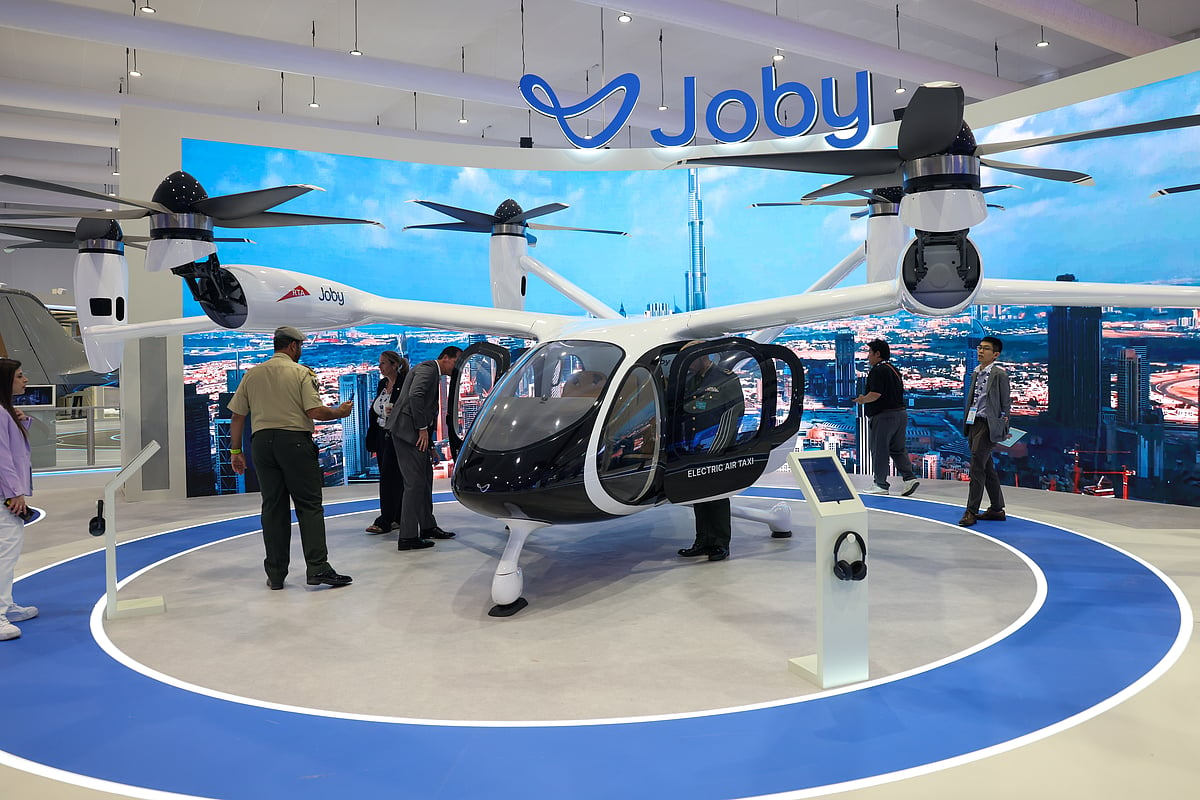The buzz at the Dubai Airshow 2025 is unlike any other.
Joby Aviation’s electric vertical takeoff and landing (eVTOL) aircraft is soaring through the skies.
At the sprawling Al Maktoum-Dubai World Central, which hosts the on-going Dubai Airshow 2025, a quiet revolution hums to life.
A few days earlier, Joby flew its historic first crewed flight in the country.
This isn’t mere spectacle — it’s the dawn of urban air mobility (UAM). And Dubai has staked its claim as the global birthplace of air taxis.
Ambition
What makes Dubai the epicentre?
Start with bold ambition. As a gleaming metropolis, where millions of expats live alongside Emiratis, Dubai grapples with gridlock on its six-lane highways (esp. on Al Ittihad Road, Dubai-Sharjah's main artery), where rush-hour commutes can stretch 45 minutes across just 10-15km.
Enter Joby Aviation, the California-based pioneer whose S4 eVTOL promises 200 mph speeds, slashing that journey to a breezy 10 minutes — all-electric, whisper-quiet, and emissions-free.
Rechargeable, too, like your iPhone or Oppo.
On November 9, 2025, Joby's piloted demo zipped 17 minutes from its Margham test site to Al Maktoum International Airport, marking the UAE's inaugural point-to-point eVTOL flight.
Dubai's Roads and Transport Authority (RTA) greenlit the operation, fast-tracking what other country can only ponder.
Strategy
This isn’t wishful thinking, of serendipity; it's strategy.
DXB, already the world's busiest international airport hub, boasts vertiport-ready infrastructure: across Dubai, six planned landing pads will be integrated into malls, hotels, and the Dubai Marina by 2026.
Backed by a multi-million-dollar UAE investment, Joby eyes app-based ridesharing for tourists and execs, ferrying passengers from Palm Jumeirah to the Burj Khalifa in under five minutes.
Regulatory agility
Regulatory agility seals the deal.
While the Five Eyes, and the FAA take their sweet time in certifying Joby’s fleet, Dubai’s Civil Aviation Authority has preemptively approved operations, positioning the emirate as the testing ground for scalable urban flight.
Critics cite safety and noise.
But if Dubai's track record — from the world's tallest building and its game-changing driverless Metro, to hyperloop dreams — won't convince doubters, nothing will.
By 2026 launch, air taxis could generate $9 billion regionally, per industry forecasts. The viral clip of Joby air taxi rotors slicing azure skies, isn’t hype; it’s harbinger.
Dubai isn’t just adopting air taxis — it’s birthing them, redefining skies as highways for a congested road-based transport.
That same playbook is now being applied to the skies of tomorrow.
OK, Dubai didn’t invent the airplane. Let's not forget, the Wright brothers started off as printers and bicycle makers, but with a lofty ambition.
Dubai has turned itself into the undisputed crossroads of global aviation through sheer will, strategic initiative, and a radical “Open Skies” philosophy that welcomed every flag carrier while others clung to protectionism.
In just four decades, a desert strip with a single runway became the planet’s busiest international hub, and Emirates — launched in 1985 with two hand-me-down jets from Pakistan International Airlines — grew into the largest long-haul airline on Earth, flying more international passengers annually than Delta, United, or American.
Embracing the future
The air-taxi revolution is following the identical script, only faster.
Joby Aviation didn’t invent eVTOLs in a Dubai lab, but the emirate is doing what it has always done: spotting the next leap in mobility, removing every regulatory and infrastructural obstacle at lightning speed, and betting hundreds of millions of dollars to make itself the place where the future first lands.
While California debates noise ordinances and Europe drafts decade-long certification roadmaps, Dubai’s GCAA has already issued operational approvals, its RTA has pre-built vertiports on top of malls and hotels, and its sovereign funds have written nine-figure checks.
History rhymes
In the 1980s, doubters laughed that a tiny Gulf state with no domestic market could challenge legacy giants.
Emirates answered by ordering 100+ wide-bodies at a single air show and never looked back.
Today, the skeptics say battery-powered air taxis are toys for the rich.
Dubai’s response?
A firm 2026 commercial launch with Joby, sky-high ambitions for thousands of daily flights, and a plan to make a ride from Dubai Marina to DXB cheaper than a peak-hour Careem Black.
Dubai doesn’t need to invent the technology.
It just needs to be the first city bold enough to live in the future — while everyone else is still regulating it.
That’s how a patch of sand became aviation’s capital once, and how it’s becoming the birthplace of the air-taxi era now.
Sign up for the Daily Briefing
Get the latest news and updates straight to your inbox
Network Links
GN StoreDownload our app
© Al Nisr Publishing LLC 2025. All rights reserved.
